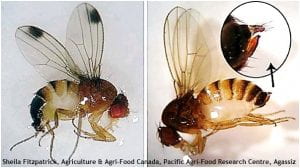Jerry Brust, IPM Vegetable Specialist, University of Maryland; jbrust@umd.edu
A sample of fruit flies was given to me by Bob Rouse, a horticultural consultant, from fruit farms he consults for in Central Maryland; these flies were identified by me and then verified by the USDA as Spotted Wing Drosophila (SWD) Drosophila suzukii, the first find in our state. This is not good, but this pest has been moving steadily east over the last few years. The SWD is a temperate-zone fruit fly; native to Southeast Asia that prefers temperatures of 67-85° F. Adults are small (2-3 mm) flies with red eyes and a pale brown thorax with black stripes on the abdomen. The most distinctive trait of the adult male is a black spot towards the tip of each wing; the female does not have any wing spots (Photo 1). Larvae are tiny (up to 3.5 mm), white, cylindrical maggots that are found feeding in fruit. This pest was first identified in the western U.S. in 2008. In 2009 it was found in California, Florida, Oregon, Utah and Washington. In the last year or so it has been found in the Midwest and Pennsylvania. Long-distance dispersal usually occurs with the movement of infested fruit to new areas.
While it is not unusual to find fruit flies in late summer infesting overripe or decaying fruit these particular fruit flies are considered nuisances, not crop damaging pests. However, the spotted wing drosophila female lays her eggs inside healthy unblemished fruit with her saw-like ovipositor (Photo 1). The adult female can damage fruit when she oviposits while larvae contaminate fruit at harvest, causing it to become soft and unmarketable (Photos 2 and 3). It infests thin-skinned fruit such as grape, cherry, raspberry, blackberry (raspberries and blackberries appear to be very susceptible fruit), blueberry, and strawberry, etc. SWD overwinters in the adult stage and flies become active in spring, mate, and lay eggs in the thin-skinned fruit. Multiple generations develop each year wherever this insect can overwinter. At a constant temperature of about 75°F it takes only 9 days from egg to adult. This rapid developmental rate allows it to quickly develop large populations and inflict severe damage to a crop.
The best thing to do is monitor for this pest if you have small fruit. Monitoring will help time insecticide applications for greatest effectiveness. You can use homemade traps to monitor for SWD. There are several sites that explain how to make the traps:
http://swd.hort.oregonstate.edu/files/webfm/editor/Wine_Grape_SWD_Bulletin_WSU.pdf
http://jenny.tfrec.wsu.edu/opm/gallery.php?pn=165
http://edis.ifas.ufl.edu/in839
or you can buy commercially made traps: http://www.contech-inc.com/
or
http://ipm.wsu.edu/small/pdf/Spring2011MonitorIDControlSWD.pdf
For any of these traps you will need to add 1 or 2 inches of apple cider vinegar to the bottom of the trap with a drop of unscented dishwashing soap to break the surface tension so the flies will drown. Hang the trap in the shade near berries preferably before fruit begins to ripen. Check the trap weekly for small flies with dark spots at the tip of their wings floating in the fluid. These will be male SWD. Put fresh apple cider vinegar and a drop of soap in each week or so. You also should observe your fruit regularly as it begins to ripen. On cherries and blueberries start checking fruit for punctures the female creates when she lays eggs as soon as fruit begins to develop any color. SWD stings are tiny and a hand lens helps. Pull open suspect fruit to see if there are larvae inside. If you find infected fruit you should spray to prevent the damage from increasing. The infestation level can increase quite rapidly if left untreated. Remove and destroy infested fruit as you monitor. Stings are not readily visible on berries so it is difficult to detect an early infestation by monitoring the fruit alone for damage.
Chemical Management: Malathion will control SWD and has a short PHI, but is very toxic to bees and natural enemies. If monitoring indicates a need to spray, the application should be made as soon as possible. In raspberries or strawberries, sprays may need to be repeated to keep SWD populations low during their prolonged fruiting period in summer and fall. Other possible alternatives to Malathion with fewer negative environmental effects are the spinosyns and neonicotinoids. To get satisfactory control with these alternatives two sprays may be required; the second applied 5 to 7 days after the first. Additional sprays may be needed for berries with a prolonged fruiting period. Be sure to check the label before applying any chemical as the specific chemicals that can be used on one fruit can’t always be used on others.
Photo 2. SWD damage in blackberry



